
Electric vehicle manufacturer Rivian (NASDAQ: RIVN) reported Q4 CY2024 results exceeding the market’s revenue expectations, with sales up 31.9% year on year to $1.73 billion. Its non-GAAP loss of $0.46 per share was 28.1% above analysts’ consensus estimates.
Is now the time to buy Rivian? Find out by accessing our full research report, it’s free.
Rivian (RIVN) Q4 CY2024 Highlights:
- Revenue: $1.73 billion vs analyst estimates of $1.42 billion (31.9% year-on-year growth, 22.4% beat)
- Adjusted EPS: -$0.46 vs analyst estimates of -$0.64 (28.1% beat)
- Adjusted EBITDA: -$277 million vs analyst estimates of -$408 million (-16% margin, 32.1% beat)
- EBITDA guidance for the upcoming financial year 2025 is -$1.8 billion at the midpoint, below analyst estimates of -$1.69 billion
- Operating Margin: -38.1%, up from -120% in the same quarter last year
- Free Cash Flow was $856 million, up from -$1.41 billion in the same quarter last year
- Sales Volumes rose 1.5% year on year (73.5% in the same quarter last year)
- Market Capitalization: $14.22 billion
Company Overview
The manufacturer of Amazon’s delivery trucks, Rivian (NASDAQ: RIVN) designs, manufactures, and sells electric vehicles and commercial delivery vans.
Automobile Manufacturing
Much capital investment and technical know-how are needed to manufacture functional, safe, and aesthetically pleasing automobiles for the mass market. Barriers to entry are therefore high, and auto manufacturers with economies of scale can boast strong economic moats. However, this doesn’t insulate them from new entrants, as electric vehicles (EVs) have entered the market and are upending it. This has forced established manufacturers to not only contend with emerging EV-first competitors but also decide how much they want to invest in these disruptive technologies, which will likely cannibalize their legacy offerings.
Sales Growth
Reviewing a company’s long-term sales performance reveals insights into its quality. Any business can have short-term success, but a top-tier one grows for years. Luckily, Rivian’s sales grew at an incredible 262% compounded annual growth rate over the last three years. Its growth beat the average industrials company and shows its offerings resonate with customers.
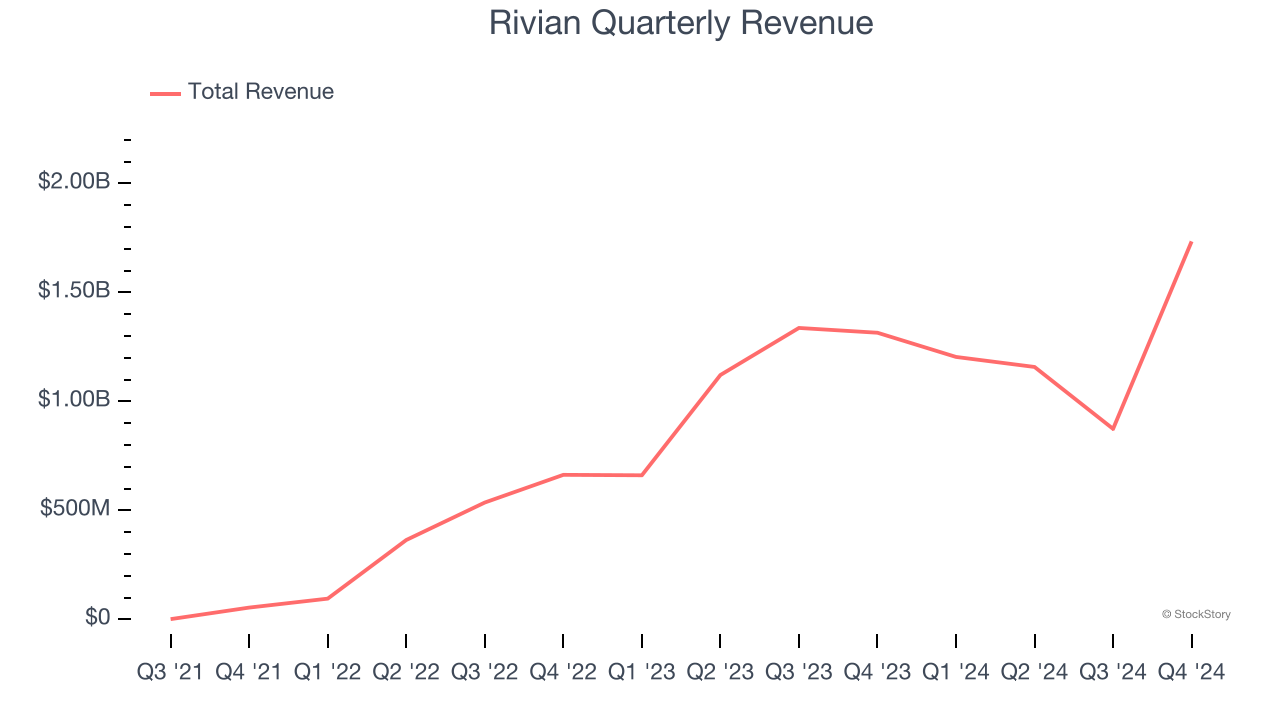
Long-term growth is the most important, but within industrials, a stretched historical view may miss new industry trends or demand cycles. Rivian’s annualized revenue growth of 73.1% over the last two years is below its three-year trend, but we still think the results were good and suggest demand was strong. 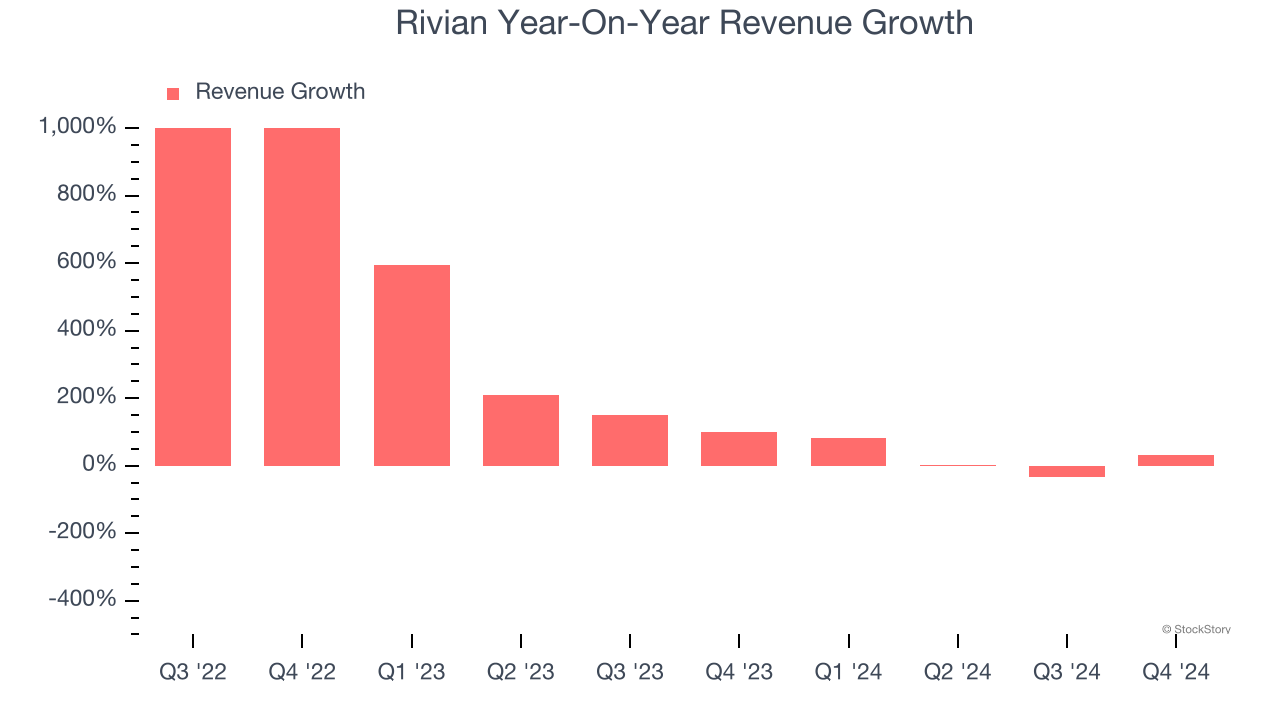
We can dig further into the company’s revenue dynamics by analyzing its number of vehicles delivered, which reached 14,183 in the latest quarter. Over the last two years, Rivian’s vehicles delivered grew by 59.3% annually. Because this number is lower than its revenue growth, we can see the company benefited from price increases. 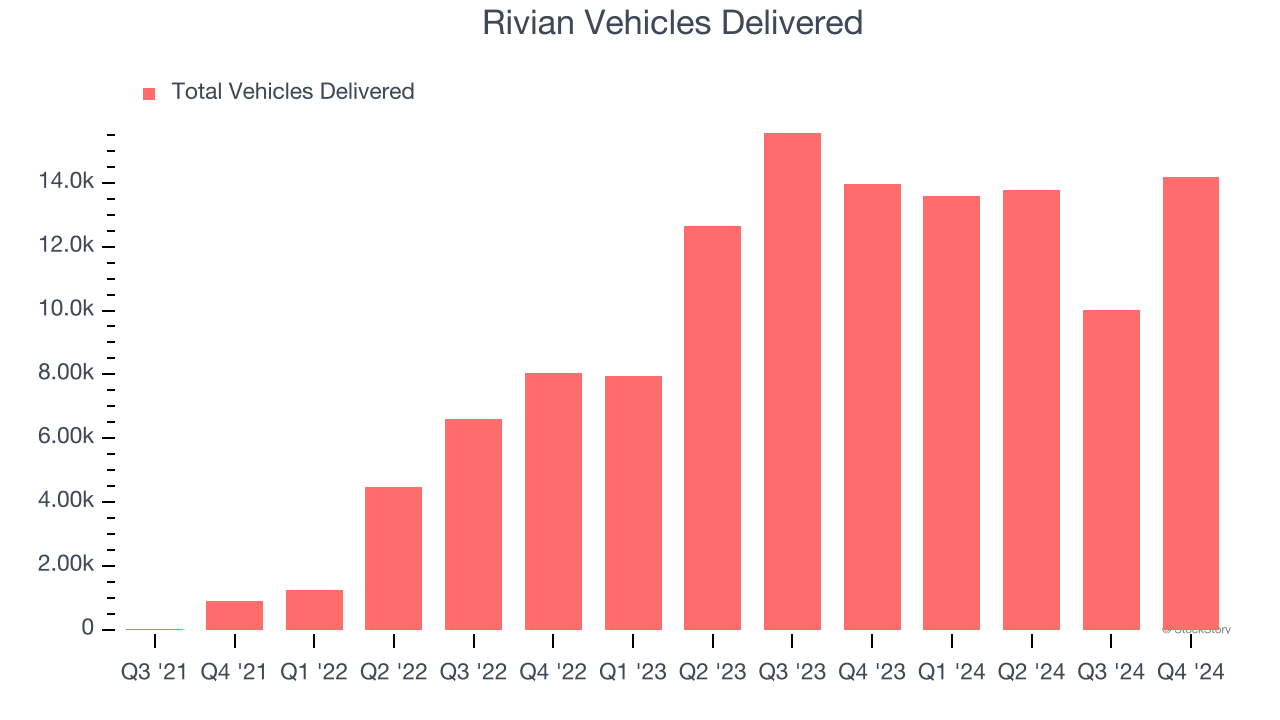
This quarter, Rivian reported wonderful year-on-year revenue growth of 31.9%, and its $1.73 billion of revenue exceeded Wall Street’s estimates by 22.4%.
Looking ahead, sell-side analysts expect revenue to decline by 2.4% over the next 12 months, a deceleration versus the last two years. This projection is underwhelming and implies its products and services will face some demand challenges.
Today’s young investors won’t have read the timeless lessons in Gorilla Game: Picking Winners In High Technology because it was written more than 20 years ago when Microsoft and Apple were first establishing their supremacy. But if we apply the same principles, then enterprise software stocks leveraging their own generative AI capabilities may well be the Gorillas of the future. So, in that spirit, we are excited to present our Special Free Report on a profitable, fast-growing enterprise software stock that is already riding the automation wave and looking to catch the generative AI next.
Operating Margin
Operating margin is an important measure of profitability as it shows the portion of revenue left after accounting for all core expenses – everything from the cost of goods sold to advertising and wages. It’s also useful for comparing profitability across companies with different levels of debt and tax rates because it excludes interest and taxes.
Rivian’s high expenses have contributed to an average operating margin of negative 185% over the last four years. Unprofitable industrials companies require extra attention because they could get caught swimming naked when the tide goes out. It’s hard to trust that the business can endure a full cycle.
On the plus side, Rivian’s operating margin rose over the last four years, as its sales growth gave it operating leverage. Still, it will take much more for the company to reach long-term profitability.
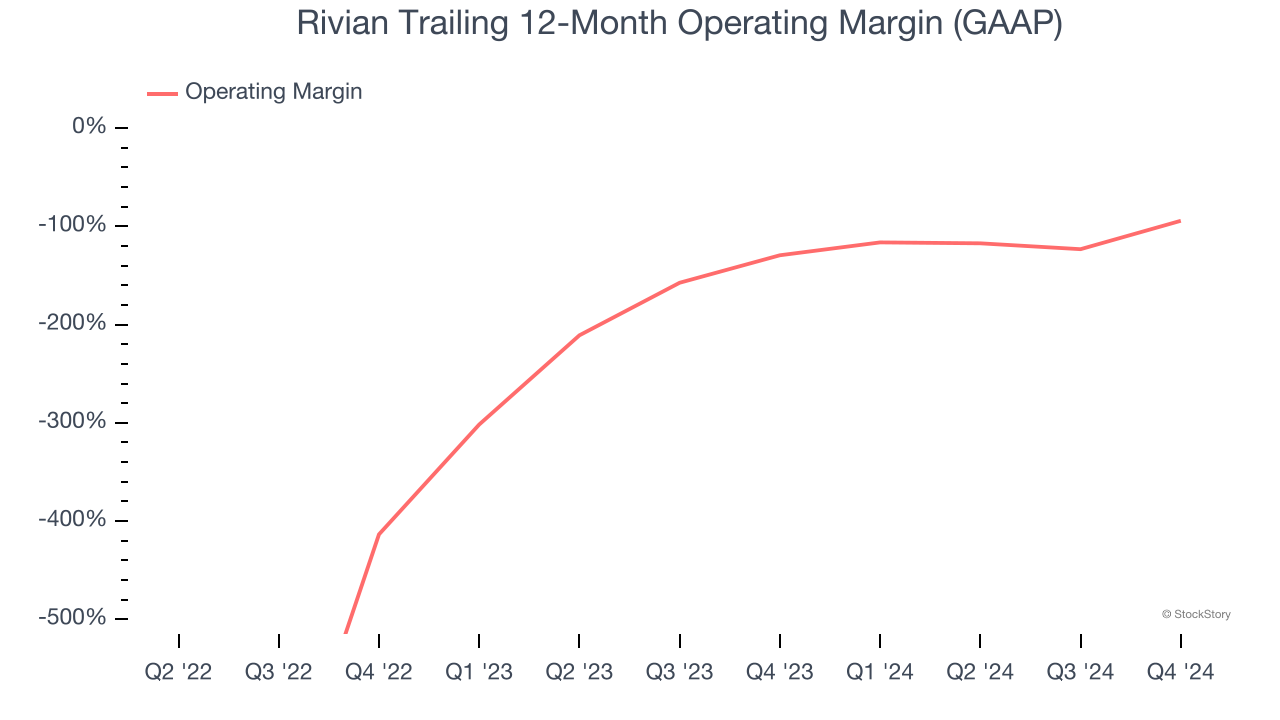
Rivian’s operating margin was negative 38.1% this quarter. The company's consistent lack of profits raise a flag.
Earnings Per Share
Revenue trends explain a company’s historical growth, but the long-term change in earnings per share (EPS) points to the profitability of that growth – for example, a company could inflate its sales through excessive spending on advertising and promotions.
Although Rivian’s full-year earnings are still negative, it reduced its losses and improved its EPS by 10.1% annually over the last five years. The next few quarters will be critical for assessing its long-term profitability. We hope to see an inflection point soon, especially since it recently diluted shareholders by forming a $5.8 billion joint venture with Volkswagen in November 2024.
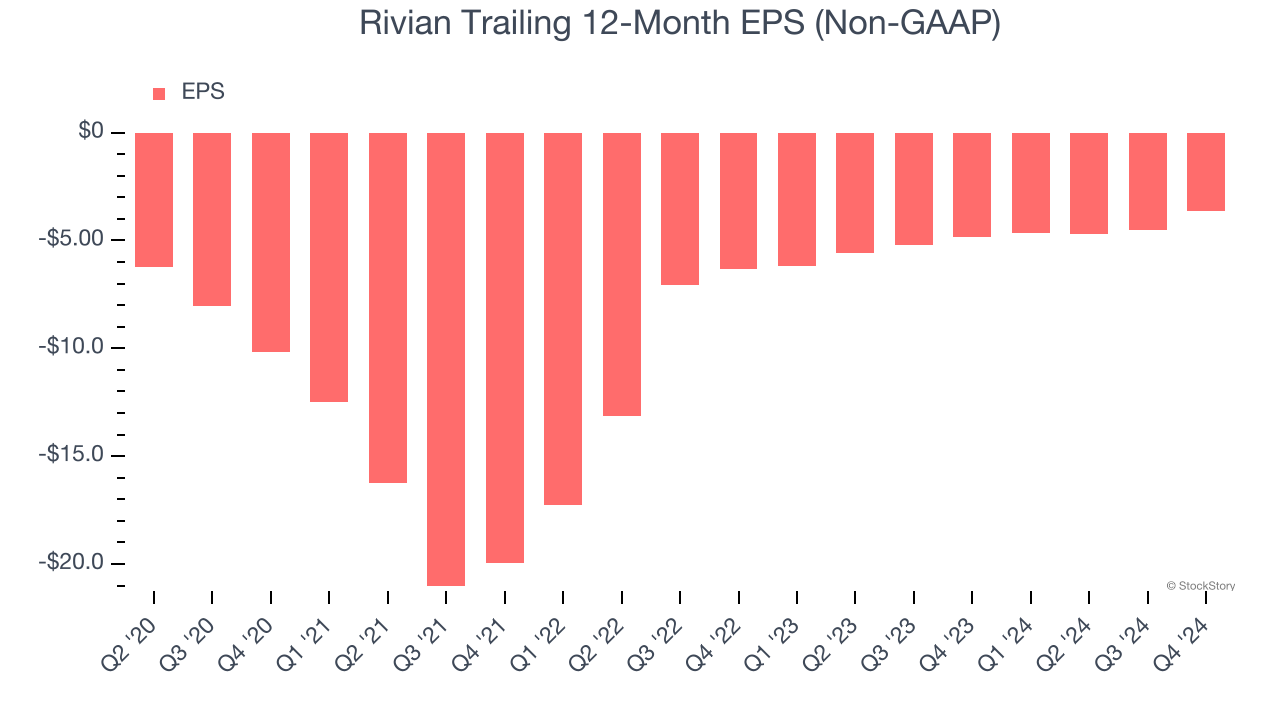
Like with revenue, we analyze EPS over a shorter period to see if we are missing a change in the business.
For Rivian, its two-year annual EPS growth of 24.4% was higher than its five-year trend. We love it when earnings improve, but a caveat is that its EPS is still in the red.
In Q4, Rivian reported EPS at negative $0.46, up from negative $1.36 in the same quarter last year. This print easily cleared analysts’ estimates, and shareholders should be content with the results. Over the next 12 months, Wall Street expects Rivian to improve its earnings losses. Analysts forecast its full-year EPS of negative $3.62 will advance to negative $2.70.
Key Takeaways from Rivian’s Q4 Results
We were impressed by how significantly Rivian blew past analysts’ revenue, EPS, and EBITDA expectations this quarter. Importantly, its gross margin and free cash flow finally reached positive territory, marking a potential inflection point. Rivian had struggled with negative gross margins for quite some time before this print - the main reason it had to cut a ~$5.8 billion deal with Volkswagen in November 2024. In terms of downsides, its full-year EBITDA guidance missed, but it didn't matter much given the previously mentioned facts. Zooming out, we think this was a good quarter with some key areas of upside. The stock traded up 3.8% to $14.09 immediately after reporting.
Rivian may have had a good quarter, but does that mean you should invest right now? If you’re making that decision, you should consider the bigger picture of valuation, business qualities, as well as the latest earnings. We cover that in our actionable full research report which you can read here, it’s free.





